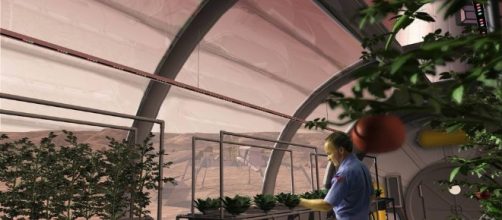One of the necessities for sustaining life is food. Astronauts who have traveled in space have taken their food with them, ranging from the goop squeezed from plastic tubes in the early days to microwavable dinners that astronauts on the international space station enjoy today. Future space explorers, who may spend months or even years on the moon or Mars, will have to grow their own food. Scientists at NASA and the University of Arizona are developing an inflatable greenhouse that will not only provide fresh vegetables and fruit for astronauts but will help to recycle the air.
Water would feed the plants, likely derived from local sources, filled with nutrients continuously circulated in the root systems, CO2, breathed out by the astronauts, would be pumped into the greenhouse. Oxygen would be pumped out. Illumination would be provided by LED lights supplemented by natural sunlight piped in through fiber optic cables. The greenhouses would likely be inside larger habitats or buried underground to protect them from radiation and micrometeorites.
Scientists are now trying to ascertain what kind of plants and seeds will provide an optimal balanced diet for astronauts on long-duration space missions. Another factor that will be hard to replicate on Earth will be how low gravity affects plant growth.
The moon has one-sixth the gravity of Earth and Mars about one-third.
In the meantime, the astronauts have had some success growing food plants on board the International Space Station in the Vegetable Production System (Veggie) experiment that featured astronauts growing food under meticulously controlled conditions. A second stage experiment, called the Advanced Plant Habitat (APH) was recently delivered to the ISS to expand space farming on board the orbiting laboratory. The APH not only has more advanced lighting that is hoped to quadruple crop yield but a suite of sensors that will track plant growth under space conditions.
The technology for growing food in space may be adapted for Earth agriculture.
“Vertical Farming” is a concept in which large amounts of food is grown under controlled conditions inside warehouses located in urban centers. The idea is that more food can be produced cheaper with lighting, air, and light under tight control than the traditional way in the ground under sunlight and rain. The fact that the vertical farms are located close to food retail outlets such as supermarkets is another plus. So far attempts to make these kinds of urban farms economically viable have had mixed results. However, given time and investments, advocates believe that the approach will serve as a new source of food divorced from the vagaries of weather. The fact that no pesticides will be needed is another plus.

